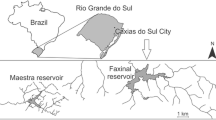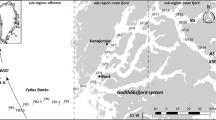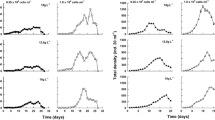Abstract
A red tide of the marine dinoflagellate Heterocapsa triquetra (Ehrenberg) Stein was studied in the fjordlike Mariehamn ferry harbour area (Åland, SW Finland) in 1996. The red tide started in mid-July in the inner harbour area where high phosphorus levels and low TN:TP ratios were recorded. In red water the H. triquetra densities often exceeded 5000 cells ml−1 and the chlorophyll a levels locally exceeded 20 μg l−1 in late July and early August. Despite frequent and deep mixing due to ship traffic, H. triquetra formed near-surface maxima. Artificial mixing by scheduled traffic constitutes an unnatural selection mechanism, theoretically favouring fast-swimming phytoplankters like H. triquetra.
Similar content being viewed by others
References
Anderson, F. E., 1976. Rapid settling rates observed in sediments resuspended by boat waves over a tidal flat. Neth. J. Sea Res. 10: 44–58.
Blomqvist, E. M., 1993 (Ed.). Fartygstrafikens miljökonsekvenser (“Environmental consequences of ships' traffic”). Nordiska ministerrådets skärgårdssamarbete, Rapport 1993 (5): 1–86 (mainly in Swedish).
Bonsdorff, E., E. M. Blomqvist, J. Mattila & A. Norkko, 1997. Long-term changes and coastal eutrophication. Examples from the Åland Islands and the Archipelago Sea, Northern Baltic Sea. Oceanol. Acta 20: 319–329.
Carrick, H. J., F. J. Aldridge & C. L. Schelske, 1993. Wind in-fluences phytoplankton biomass and composition in a shallow, productive lake. Limnol. Oceanogr. 38: 1179–1192.
Cloern, J. E., 1991. Tidal stirring and phytoplankton bloom dynamics in an estuary. J. Mar. Res. 49: 203–221.
Edler, L. (ed.), 1979. Recommendations on methods for marine biological studies in the Baltic Sea. Phytoplankton and chlorophyll. The Baltic Marine Biologists Publication 3: 1–38. (Published by the National Swedish Environment Protection Board).
Fagerholm, H-P., O. Rönnberg, M. Östman & J. Paavilainen, 1991. Remote sensing assessing artificial disturbance of the thermocline by ships in archipelagoes of the Baltic Sea with a note on some biological consequenses. In Remote Sensing: Global Monitoring for Earth Management (International Geoscience andRemote Sensing Symposium, Espoo, Finland, 3–6 June, 1991), Vol. 2: 377–380.
Fichez, R., T. D. Jickels & H. M. Edmunds, 1992. Algal blooms in high turbidity, a result of the conflicting consequences of turbulence on nutrient cycling in a shallow water estuary. Estuar. Coast. Shelf Sci. 35: 577–592.
Hansen, P. J., 1995. Growth and grazing response of a ciliate feeding on the red tide dinoflagellate Gyrodinium aureolum in monoculture and in mixture with a non-toxic alga. Mar. Ecol. Prog. Ser. 121: 65–72.
Kononen, K, J. Kuparinen, J. Mäkelä, J. Laanemets, J. Pavelson & S. Nommann, 1996. Initiation of cyanobacterial blooms in a frontal region at the entrance of the Gulf of Finland, Baltic Sea. Limnol. Oceanogr. 41: 98–112.
Koroleff, F., 1979. Meriveden yleisimmät kemialliset analyysimenetelmät (Methods for chemical analysis of sea water). Meri 7: 1–60 (in Finnish).
Lindholm, T., 1997. Färjor ger fart åt alger (Ferry traffic speeds up phytoplankton). Vatten 53: 133–136 (in Swedish).
Lindholm, T. & P. Öhman, 1995a. Occurrence of bloom-forming and potentially harmful phytoplankton in the Åland archipelago in the summer of 1993. Memoranda Soc. Fauna Flora Fenn. 71: 10–18.
Lindholm, T. & P. Öhman, 1995b. Stratification patterns and chlorophyll a distribution in archipelago inlets of the Åland-Houtskär areas, SW Finland. Memoranda Soc. Fauna Flora Fenn. 71: 63–69.
Lizon, F., Y. Lagadeuc, C. Brunet, D. Aelbrecht & D. Bentley, 1995. Primary production and photoadaptation of phytoplankton in relation with tidal mixing in coastal waters. J. Plankton Res. 17: 1039–1055.
Madekivi, O. (ed.), 1993. Alusten aiheuttamien aaltojen ja virtausten ympäristövaikutukset (The environmental effects of shipinduced waves and currents). Vesi ja Ympäristöhallinnon Julk. Sarja A 166: 1–113 (in Finnish).
Nagai, K., Y. Matsuyama, T. Uchida, M. Yamaguchi, M. Ishimura, A. Nishimura, S. Akamatsu & T. Honjo, 1996. Toxicity and LD50 levels of the red tide dinoflagellate Heterocapsa circularisquama on juvenile pearl oysters. Aquaculture 144: 149–154.
Niemi, Å. & G. Hällfors, 1974. Some phytoplankton species from Baltic waters. Memoranda Soc. Fauna Flora Fenn. 49: 77–93.
Östman, M. & O. Rönnberg, 1991. Effects of ships' waves on rockpools in the Åland archipelago, northern Baltic Sea. Sarsia 76: 125–132.
Reynolds, C. S., 1984. The Ecology of Freshwater Phytoplankton. Cambridge University Press, Cambridge.
Reynolds, C. S., 1996. Phosphorus recycling in lakes: evidence from large limnetic enclosures for the importance of shallow sediments. Freshwat. Biol. 35: 623–645.
Reynolds, C. S., S.W. Wiseman and M. J. O. Clarke, 1984. Growthand loss-rate responses of phytoplankton to intermittent artificial mixing and their potential application to the control of planktonic algal biomass. J. appl. Ecol. 21: 11–39.
Robinson, M. G. & L. N. Brown, 1983. A recurrent red tide in a British Columbia coastal lagoon. Can. J. Fish. aquat. Sci. 40: 2135–2143.
Rönnberg, O., 1981. Traffic effects on rocky-shore algae in the Archipelago Sea, SW Finland. Acta Acad. Aboensis Ser. B. 41: 1–86.
Uchida, T., M. Yamaguchi, Y. Matsuyama & T. Honjo, 1995. The red-tide dinoflagellate Heterocapsa sp. kills Gyrodinium instriatum by cell contact. Mar. Ecol. Prog. Ser. 118: 301–303.
Välikangas, I, 1926. Planktologische Untersuchungen im Hafengebiet von Helsingfors. I. Ñber das Plankton insbesondere der Netz-zooplankton des Sommerhalbjahres. Acta Zool. Fenn. 1: 1–298.
Viljamaa, H. 1977. Kasviplankton (Phytoplankton). In: Pesonen, L. (ed) Investigation of Helsinki and Espoo Sea Areas in 1976. Reports of the Water Conservation Laboratory, Helsinki: 73–97 (in Finnish, English summary).
Voipio, A. (ed.), 1981. The Baltic Sea. Elsevier, Amsterdam.
Author information
Authors and Affiliations
Rights and permissions
About this article
Cite this article
Lindholm, T., Nummelin, C. Red tide of the dinoflagellate Heterocapsa triquetra (Dinophyta) in a ferry-mixed coastal inlet. Hydrobiologia 393, 245–251 (1999). https://doi.org/10.1023/A:1003563022422
Issue Date:
DOI: https://doi.org/10.1023/A:1003563022422




